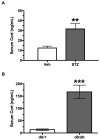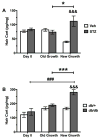Hair corticosterone measurement in mouse models of type 1 and type 2 diabetes mellitus
- PMID: 28089708
- PMCID: PMC5507747
- DOI: 10.1016/j.physbeh.2017.01.018
Hair corticosterone measurement in mouse models of type 1 and type 2 diabetes mellitus
Abstract
In diabetes, glucocorticoid secretion increases secondary to hyperglycemia and is associated with an extensive list of disease complications. Levels of cortisol in humans, or corticosterone in rodents, are usually measured as transitory biomarkers of stress in blood or saliva. Glucocorticoid concentrations accumulate in human or animal hair over weeks and could more accurately measure the cumulative stress burden of diseases like chronic diabetes. In this study, corticosterone levels were measured in hair in verified rodent models of diabetes mellitus. To induce type 1 diabetes, C57BL/6J mice were injected with streptozotocin and blood and hair samples were collected 28days following induction. Leptin receptor deficient (db/db) mice were used as a spontaneous model of type 2 diabetes and blood and hair samples were collected at 8weeks of age, after the development of hyperglycemia and obesity. Corticosterone levels from serum, new growth hair and total growth hair were analyzed using an enzyme immunoassay. Corticosterone levels in new growth hair and serum were significantly elevated in both models of diabetes compared to controls. In contrast, corticosterone levels in old hair growth did not differ significantly between diabetic and non-diabetic animals. Thus, hair removal and sampling of new hair growth was a more sensitive procedure for detecting changes in hair corticosterone levels induced by periods of hyperglycemia lasting for 4weeks in mice. These results validate the use of hair to measure long-term changes in corticosterone induced by diabetes in rodent models. Further studies are now needed to validate the utility of hair cortisol as a tool for measuring the stress burden of individuals with diabetes and for following the effects of long-term medical treatments.
Keywords: Corticosterone; Diabetes; Hair; Mouse; Streptozotocin.
Copyright © 2017 Elsevier Inc. All rights reserved.
Figures



References
-
- Tamashiro KL, Nguyen MM, Fujikawa T, Xu T, Yun Ma L, Woods SC, et al. Metabolic and endocrine consequences of social stress in a visible burrow system. Physiol Behav. 2004;80:683–93. - PubMed
-
- Tamashiro KL, Hegeman MA, Sakai RR. Chronic social stress in a changing dietary environment. Physiol Behav. 2006;89:536–42. - PubMed
-
- Tamashiro KL, Sakai RR, Shively CA, Karatsoreos IN, Reagan LP. Chronic stress, metabolism, and metabolic syndrome. Stress. 2011;14:468–74. - PubMed
-
- Diagnosis and classification of diabetes mellitus. Diabetes Care. 2005:28. - PubMed
-
- Arnaldi G, Angeli A, Atkinson AB, Bertagna X, Cavagnini F, Chrousos GP, et al. Diagnosis and complications of Cushing’s syndrome: a consensus statement. The Journal of clinical endocrinology and metabolism. 2003;88:5593–602. - PubMed
MeSH terms
Substances
Grants and funding
LinkOut - more resources
Full Text Sources
Other Literature Sources
Medical
Miscellaneous

